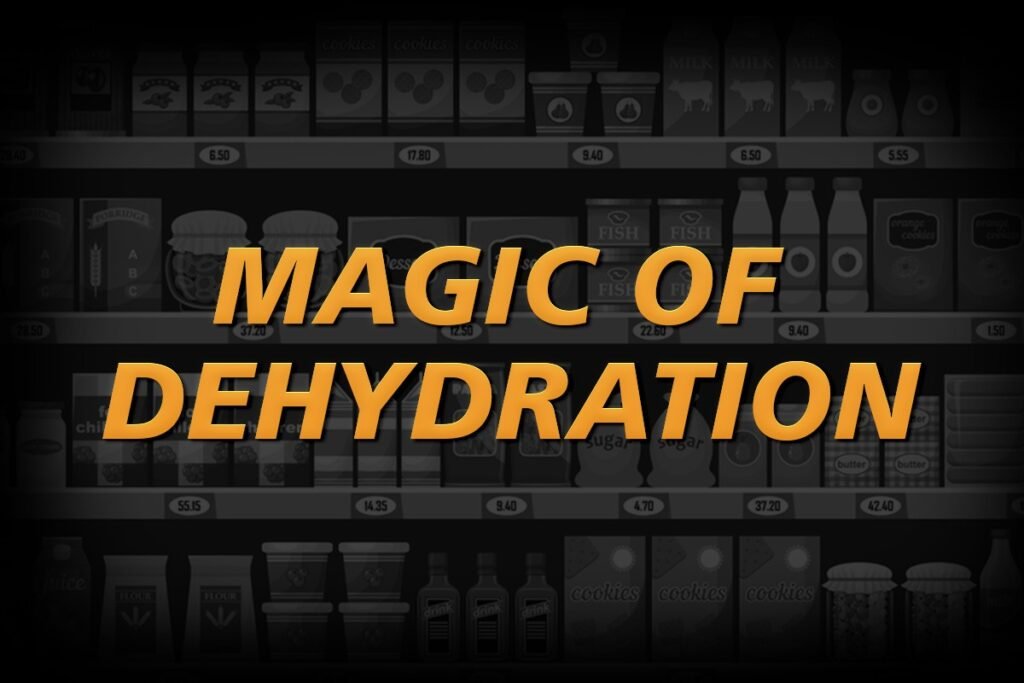Dehydration is a fascinating process with a wide variety of uses. One of the most exciting applications of dehydration is its ability to dramatically improve shelf life without introducing any potentially harmful preservatives. This blog post will explore the magic of dehydration and how it can be used to extend the shelf life of food products.
The Problem of Food Spoilage and Harmful Preservatives
Food spoilage is a major concern in the food industry. Fresh fruits and vegetables, along with other perishable food products, have a limited shelf life due to their high moisture content. When exposed to air, bacteria, molds, and yeast can thrive, leading to food spoilage and potentially harmful bacterial growth.
To combat this issue, food manufacturers often resort to using preservatives to prolong the shelf life of their products. However, many of these preservatives can be harmful to our health. They can lead to allergic reactions, digestive issues, and even contribute to chronic diseases.
Additionally, consumers are increasingly demanding natural and organic products that are free from artificial preservatives. This creates a challenge for the food industry to find alternative methods to extend the shelf life of their products without compromising on quality and safety.
This is where dehydration technology comes into play. By removing moisture from food products, dehydration inhibits the growth of microorganisms that cause spoilage. This process involves either natural methods such as sun drying or more advanced techniques like tray drying, vacuum drying, and freeze drying. These methods help to control temperature, humidity, and air circulation to achieve the desired level of dehydration.
What is Dehydration Technology?
Dehydration technology is a process that involves removing moisture from food products to extend their shelf life. By reducing the water content, dehydration inhibits the growth of microorganisms that cause spoilage and degradation. This preservation method has been used for centuries, but advancements in technology have made it more efficient and versatile.
One common method of dehydration is evaporation, where heat is applied to the food to remove moisture. Another method is vacuum drying, which involves placing the food in a vacuum-sealed chamber and applying low temperatures to extract the water. Humidity control is crucial during the dehydration process to ensure optimal drying conditions.
Dehydration technology can be applied to a wide range of food products, including fruits, vegetables, grains, and even meat. It is particularly beneficial for preserving perishable items such as leafy vegetables, sprouts, and millet-based products. Dehydrated foods can be stored for extended periods without the need for refrigeration or harmful preservatives.
This technology has also revolutionized the convenience food industry, allowing for the production of ready-to-cook gravies, instant premixes, and breakfast premixes. These products offer a healthy option for busy individuals who want to enjoy nutritious meals without compromising on taste or quality.
Benefits of Using Dehydration Technology for Food Preservation
Dehydration technology offers numerous benefits when it comes to food preservation. Firstly, it significantly extends the shelf life of food products without the need for harmful preservatives. This is a huge advantage for both food manufacturers and consumers. By removing moisture from the food, dehydration inhibits the growth of microorganisms that cause spoilage, ensuring that the products remain safe to consume for a longer period of time.
Another benefit of using dehydration technology is that it allows for the preservation of nutrients. Unlike traditional preservation methods such as canning or freezing, dehydration does not destroy or alter the nutritional value of the food. This means that consumers can enjoy the same level of vitamins, minerals, and antioxidants even after the dehydration process.
Additionally, dehydrated food is lightweight and compact, making it ideal for storage and transportation. The removal of water reduces the overall weight of the food, making it easier and more cost-effective to ship and store in large quantities.
Different Methods of Dehydration Technology
Dehydration technology offers a range of methods to remove moisture from food products and extend their shelf life. Two common methods used in this process are vacuum drying and low-temperature drying.
Vaccum drying is a method that involves placing the food in a vacuum-sealed chamber and applying low temperatures to extract the water. This process is particularly effective for delicate fruits and vegetables that can easily lose their shape, texture, and flavor with traditional drying methods. By reducing the pressure and temperature in the chamber, vacuum drying allows for gentle dehydration, preserving the nutritional value and taste of the food.
Low-temperature drying is another method that is commonly used in the dehydration process. This method involves maintaining a constant low temperature while circulating warm air around the food. The warm air helps to evaporate the moisture from the food while maintaining the integrity of its nutrients. Low-temperature drying is especially suitable for delicate foods like herbs, spices, and leafy greens.
Applications of Dehydration Technology in Food Preservation
Dehydration technology has revolutionized the food industry by offering a wide range of applications for preserving various types of food products. One of the most notable applications is in the production of dehydrated fruits and vegetables. These products have become increasingly popular due to their extended shelf life, convenient storage, and ease of use.
Dehydrated fruits and vegetables are not only lightweight and compact, but they also retain much of their nutritional value and flavor. This makes them an excellent choice for hikers, campers, and individuals on the go who want to enjoy the benefits of fresh produce without the risk of spoilage. Dehydration technology also allows for the creation of dehydrated powders and flakes, which can be easily rehydrated for use in soups, stews, and sauces.
Another application of dehydration technology is in the production of dried herbs and spices. By removing moisture from these ingredients, their flavor is concentrated, resulting in a more potent and aromatic product. Dried herbs and spices have a longer shelf life compared to fresh ones, allowing consumers to enjoy their favorite flavors all year round.
Dehydration technology also plays a crucial role in the production of instant noodles and ready-to-eat meals. Through the process of low-temperature drying, these products can be dehydrated while retaining their taste, texture, and nutritional content. This allows for easy and convenient meals that can be prepared in minutes by simply adding hot water.
Furthermore, dehydration technology has been utilized in the production of jerky and dried meats. By removing moisture, the growth of bacteria and microorganisms is inhibited, allowing for safe storage and longer shelf life. Dehydrated meats are a popular snack option and are also used in the production of ready-to-eat meals, adding a flavorful protein source to the dishes.
Overall, the applications of dehydration technology in food preservation are vast and varied. From fruits and vegetables to herbs, spices, and even meat, this innovative technology offers endless possibilities for extending the shelf life of food products while maintaining their nutritional value and flavor. The convenience and versatility of dehydrated foods make them an ideal choice for consumers and businesses alike.
Case Studies: Success Stories of Businesses Using Dehydration Technology
In this section, we will delve into the success stories of businesses that have harnessed the power of dehydration technology to extend the shelf life of their products. These companies have embraced this innovative preservation method and reaped the rewards of increased product longevity, customer satisfaction, and market success.
One standout success story is the company ABC Dehydrated Foods, which specializes in dehydrating fruits and vegetables. By using low-temperature drying, they have been able to create a range of dehydrated products that maintain the taste, texture, and nutritional value of fresh produce. ABC Dehydrated Foods has seen a significant increase in demand for their products, especially from health-conscious consumers who want convenient, healthy options that are free from harmful preservatives.
Another business that has embraced dehydration technology is XYZ Meat Snacks. By utilizing low-temperature drying methods, they have been able to create flavorful and shelf-stable jerky and dried meat products. These snacks have gained popularity among fitness enthusiasts, outdoor adventurers, and those looking for a convenient and protein-rich on-the-go snack option.
The success stories of ABC Dehydrated Foods and XYZ Meat Snacks highlight the versatility and effectiveness of dehydration technology in food preservation. These businesses have not only extended the shelf life of their products but have also tapped into the growing demand for healthy, natural, and convenient food options. Their success serves as inspiration for other companies to explore the possibilities of dehydration technology and harness its magic to revolutionize their own food preservation methods.
Challenges and Limitations of Dehydration Technology
While dehydration technology offers numerous benefits for food preservation, it is not without its challenges and limitations. One of the main challenges is the potential for nutrient loss during the dehydration process. While dehydration can retain much of the nutritional value of food, certain vitamins and minerals, such as vitamin C, can be more sensitive to heat and may degrade during the drying process. This is especially true with traditional dehydration methods that involve high temperatures. However, advancements in technology, such as low-temperature drying, have helped minimize nutrient loss and preserve the nutritional content of dehydrated foods.
Another challenge is the time and energy required for the dehydration process. Dehydration can be a time-consuming process, as it often requires the food to be dried for an extended period to remove all moisture. Additionally, the use of high temperatures in traditional drying methods can result in increased energy consumption. However, low-temperature drying methods, like vacuum drying, can help reduce energy consumption while maintaining the quality of the food.
Storage and packaging are also considerations when it comes to dehydrated foods. While dehydrated foods have an extended shelf life, they still require proper storage to maintain their quality. It is essential to store dehydrated foods in a cool, dry place away from moisture and light to prevent spoilage. Additionally, dehydrated foods can be more fragile and susceptible to damage, so careful packaging is necessary to prevent crushing or breakage during transportation.
Despite these challenges, dehydration technology continues to evolve, and ongoing research is focused on addressing these limitations. Innovations in low-temperature drying and packaging techniques aim to improve the quality and convenience of dehydrated foods. By overcoming these challenges, dehydration technology has the potential to revolutionize food preservation and offer consumers a safe and convenient way to enjoy nutritious foods with an extended shelf life.
Future Trends in Dehydration Technology
As dehydration technology continues to advance, there are several exciting future trends on the horizon. One of these trends is the continued development of low temperature drying methods. While traditional dehydration methods often involve high temperatures, which can result in nutrient loss, low temperature drying allows for gentler drying conditions that preserve the nutritional content of the food.
In addition to preserving nutrients, low temperature drying also helps maintain the taste and texture of the food. This is particularly beneficial for delicate fruits and vegetables that can easily lose their flavor and quality with traditional drying methods. By using low temperature drying, food manufacturers can create dehydrated products that closely resemble their fresh counterparts.
Another future trend in dehydration technology is the exploration of new and innovative drying techniques. Researchers are constantly experimenting with different drying methods and technologies to further enhance the preservation process. For example, there is ongoing research into the use of infrared drying, which uses heat generated by infrared radiation to remove moisture from food products. This method offers the potential for faster and more efficient dehydration, reducing processing time and energy consumption.
Furthermore, there is growing interest in incorporating smart technology into dehydration processes. This involves the use of sensors and automation to monitor and control the drying conditions, ensuring optimal dehydration while minimizing the risk of over-drying or under-drying. By leveraging the power of technology, food manufacturers can improve the efficiency and consistency of their dehydration processes, leading to higher quality and more reliable products.

